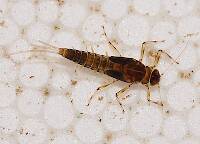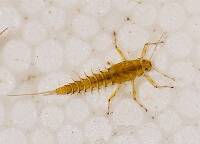
Blue-winged Olives
Baetis
Tiny Baetis mayflies are perhaps the most commonly encountered and imitated by anglers on all American trout streams due to their great abundance, widespread distribution, and trout-friendly emergence habits.
Featured on the forum

Troutnut is a project started in 2003 by salmonid ecologist Jason "Troutnut" Neuswanger to help anglers and
fly tyers unabashedly embrace the entomological side of the sport. Learn more about Troutnut or
support the project for an enhanced experience here.
Falsifly on Mar 31, 2009March 31st, 2009, 12:54 pm EDT
I have just returned from a twenty-three day fishing excursion to one of the well known Western tail-waters. This time I made the trip with my first digital camera in an attempt to capture the various stages of the order Diptera; my favorite insect to emulate in the pursuit of large Trout, and this trip was exceptional. Rather than boring you with self ego inflating fish pictures I have tried to capture the Midge in its natural environment. I have sequenced the shots from the pupae just below the surface to the spent fly. One shot in which I was particularly fortunate shows an adult half emerged from the puparium. I have included a few shots of mating clusters as a point of interest brought up on another topic. I would appreciate it if you would cut me a little bit of slack on the picture quality as I am new to this and all pictures were taken on moving water in digital macro. To capture, compose, focus and shoot, moving insects no more than an inch or two from the camera lens was a challenge to say the least.
Coming to the surface



Halfway to the new world

In the next shot the adult is frantically beating its wings in an attempt to escape from the final clutches of the puparium.

Finally on top

After much time observing mating of the hundreds of Midges crawling on my waders I found that after a male and female copulate many of what I assumed were other males tried to get in the act with the same female and thus the cluster.



Finished

Coming to the surface



Halfway to the new world

In the next shot the adult is frantically beating its wings in an attempt to escape from the final clutches of the puparium.

Finally on top

After much time observing mating of the hundreds of Midges crawling on my waders I found that after a male and female copulate many of what I assumed were other males tried to get in the act with the same female and thus the cluster.



Finished

Falsifly
When asked what I just caught that monster on I showed him. He put on his magnifiers and said, "I can't believe they can see that."
When asked what I just caught that monster on I showed him. He put on his magnifiers and said, "I can't believe they can see that."
DOS on Mar 31, 2009March 31st, 2009, 12:59 pm EDT
WOW outstanding work Falsifly! And you captured the elusive midge cluster!!
Andrew Nisbet
GONZO on Mar 31, 2009March 31st, 2009, 2:50 pm EDT
Thanks for posting these pictures, Falsifly. Great job!
PS--I believe that male chironomids are usually identified by their feathery (plumose) antennae. (Most of these appear to be female.)
PS--I believe that male chironomids are usually identified by their feathery (plumose) antennae. (Most of these appear to be female.)
DOS on Mar 31, 2009March 31st, 2009, 7:10 pm EDT
Since these appear to be mostly females, any speculation as to why they might cluster?
Also, to address again the apparent lack of observed clustering here in the east (at least in my observations and a few others), what environmental or physiological differences might account for this perceived divergence in behavior?
and Falsifly, pony up some gratuitous fish porn from your trip so I can live vicariously :)
Also, to address again the apparent lack of observed clustering here in the east (at least in my observations and a few others), what environmental or physiological differences might account for this perceived divergence in behavior?
and Falsifly, pony up some gratuitous fish porn from your trip so I can live vicariously :)
Andrew Nisbet
Patcrisci on Apr 1, 2009April 1st, 2009, 12:29 am EDT
Great pics. what camera did you use?
Pat Crisci
GONZO on Apr 1, 2009April 1st, 2009, 2:32 am EDT
Since these appear to be mostly females, any speculation as to why they might cluster?
None. There might be males involved, but the only candidate that I can spot is the one buzzing its wings on the left center of the next to last picture. It's hard to say what might be in the middle of the clusters, but Falsifly's observations indicate that he thought they were clustering around a mating pair. About the only speculation that I can offer is the guess that these might be members of the chironomid subfamily Orthocladiinae. (Many of the dark, winter-emerging midges are in this group). As I mentioned in another thread, the only time that I can remember seeing midge clusters on the water was on the Provo River in Utah. That was also in the late winter/early spring.
Maybe Beardius will look in on this discussion at some point. I know that he studied (parasitic and commensal) midges and has posted in the past.
GONZO on Apr 1, 2009April 1st, 2009, 3:46 am EDT
Upon taking a longer look at these shots, I'm now thinking that the feathery male antennae just don't show well in the photos. Female midges tend to have fatter abdomens. On that basis, there appears to be a mix of both in the clusters (though the ones with the thinner abdomens do seem to predominate). What got me thinking was the close-up picture of the single midge. Although the antennae look like those of a female, the abdomen looks male to me. (I believe those are male parts at the end of the abdomen.) I apologize for the confusion caused by my hasty comments. Mea culpa. :{
Falsifly on Apr 1, 2009April 1st, 2009, 4:34 am EDT
PS--I believe that male chironomids are usually identified by their feathery (plumose) antennae. (Most of these appear to be female.)
Thank you Gonzo for the clarification. If you are correct, and I have no reason to doubt you, than I can assume that the females gang-up on the males. If this is true it only increases my interest in the little buggers. If there is an after life I want to come back as a male midge.
and Falsifly, pony up some gratuitous fish porn from your trip so I can live vicariously :)
Andrew, unfortunately acting as pseudo photographer I did not indulge in self gratification other than to capture a few shots of my son who spent the last week showing his old man that he could catch fish.





This picture shows my advancing skill as a photographer. I actually got the fish to smile for the camera. My son’s retort: smiling my @ss, He’s laughing at you!

Great pics. what camera did you use?
Thank you Pat. The camera is a Canon SD790 IS enclosed in the Canon WP-DC24 underwater case. The case is fantastic in function and form relieving all worry of environmental damage. It enabled me to get the macro shots on the waters surface without concern for accidentally submerging the lens.
P.S.
Gonzo,
You snuck a post in on me. I rather preferred it was the females ganging up on the males, not the other way around.
Here is a shot that better shows the feathery antennae of which you speak.

Falsifly
When asked what I just caught that monster on I showed him. He put on his magnifiers and said, "I can't believe they can see that."
When asked what I just caught that monster on I showed him. He put on his magnifiers and said, "I can't believe they can see that."
GONZO on Apr 1, 2009April 1st, 2009, 4:49 am EDT
I rather preferred it was the females ganging up on the males, not the other way around.
Yes, I know what you mean, Falsifly. But if the mating behavior of midges has anything at all in common with that of humans, that probably should have been the tip-off! :)
It looks like you had a grand time fishing with your son. Thanks for the additional photos.
Patcrisci on Apr 1, 2009April 1st, 2009, 6:00 am EDT
What a super trip... and 23 days!!! I am lucky if I get to fish for 23 days a year. I guess my priorities are screwed up.
Pat Crisci
DOS on Apr 1, 2009April 1st, 2009, 8:40 am EDT
Hey Falsifly,
Thanks for the pics, that was just the fix I was looking for. Such beautiful fish and scenery you have out there. Its great that you and you son can enjoy the water together. Nothing beats some father/son fishing with a little good natured ribbing thrown in! And I don't care whether the trout are smiling or laughing at me... either way I got their attention and that's alright in my book :)
Thanks again.
P.S. I had a CanonSD model about a year ago. Excellent little camera, but it bit the dust when I dunked it in the Upper Niagara River. I should have gotten the waterproof case like you did! Now I have a Olympus Waterproof and the picture quality is nowhere near as good as the the CanonSD or CanonA560 series and both cost hundreds less! Great camera and great buy!!
Thanks for the pics, that was just the fix I was looking for. Such beautiful fish and scenery you have out there. Its great that you and you son can enjoy the water together. Nothing beats some father/son fishing with a little good natured ribbing thrown in! And I don't care whether the trout are smiling or laughing at me... either way I got their attention and that's alright in my book :)
Thanks again.
P.S. I had a CanonSD model about a year ago. Excellent little camera, but it bit the dust when I dunked it in the Upper Niagara River. I should have gotten the waterproof case like you did! Now I have a Olympus Waterproof and the picture quality is nowhere near as good as the the CanonSD or CanonA560 series and both cost hundreds less! Great camera and great buy!!
Andrew Nisbet
Shawnny3 on Apr 1, 2009April 1st, 2009, 8:59 am EDT
Great pics, Falsifly. Enjoyed them.
-Shawn
-Shawn
Jewelry-Quality Artistic Salmon Flies, by Shawn Davis
www.davisflydesigns.com
www.davisflydesigns.com
Quick Reply
Related Discussions
Topic
Replies
Last Reply
1
Nov 27, 2008
by Chris_3g
by Chris_3g
8
Jan 7, 2009
by Dgracia
by Dgracia





